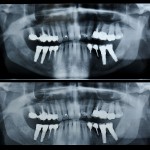
Dental implants have been used for over 50 years to aid the replacement of missing teeth. The use of implants in private practice in the UK is growing rapidly, with new technology, rather than long-term clinical evidence, driving the growth. However, uncertainty remains about the long term survival rates of the fixtures themselves. Much research has investigated early failures but how many implants fail after years of service? And do we only count them as failed if they “drop out”? What should we say to patients about the longevity of their investment?
The aim of this review was to assess the 10 year survival of titanium roughened surface, solid screw dental implants in adults.
Methods
Searches were conducted in MEDLINE, Scopus and the Cochrane library (CENTRAL). Relevant journals were hand searched and the authors sought to identify unpublished studies using PROSPERO and www.opengrey.eu. Randomised controlled trials (RCT), non-randomised or pseudo-randomised clinical trials and prospective cohort trials with a minimum of 10 participants and 35 implants were considered. The studies must have been initiated between 1st January 1997 and 1st January 2018 to reduce the risk of including ineligible implant designs. Two independent reviewers selected and extracted data with risk of bias being assessed using a tool developed for prevalence studies by Hoy et al. The survival rate at 10 years was presented according to criteria specified within each study. As a secondary analysis, survival was defined as an implant fulfilling at least one of the criteria in group IV of the International Congress of Implantologists Pisa Implant Quality of Health Scale to account for failures which were not lost from the oral cavity. Plausible imputation of missing data was also applied.
Results
- 18 studies were included.
- 4 were RCTs
- 14 prospective cohort studies
- Studies were undertaken in University clinics (n=15) or in private specialist practice (n=3)
- 5 studies were high risk of bias, with the remaining 13 being at moderate risk of bias. Common sources of bias included random selection, sampling and representativeness of sample. The risk of publication bias was increased.
- Implant Survival at 10 years
- 2688 implants included, 98 of which were lost
- Complete case analysis survival rate = 96.4% (95% CI: 0.95%-0.98%).
- Moderate heterogeneity (I2 = 54%, p=<0.01)
- True effect lies between 92-99%
- Secondary analysis using plausible imputation of data
- 2701 implants, 199 of which were lost
- Summary survival rate estimate proportion was 93.2%
- Predictive interval 77-100%
Conclusions
The authors concluded
Following conventional protocols employed in earlier reviews of 10 year implant survival the summary estimate of 96.4% demonstrates a small non-significant improvement in survival rates with the narrowing of the confidence intervals….The sensitivity meta-analysis of imputed missing data the overall summary estimate was significantly lower when compared to the complete case analysis at 93.2% and the prediction interval was considerably wider at 77-100%.
Comments
There were two ‘drop out’ issues encountered in this review. The first is whether ‘failure’ only applies to implants that are no longer in the mouth (i.e. that have ‘dropped out’!), or whether a tighter definition is needed. In this review, different definitions of failure were used in each analysis to try to establish the impact of a tighter definition of failure. It would seem that there is a significant difference, albeit small.
The second issue was of trial ‘drop outs’. That is, those participants lost to follow up (LTFU). Are they significant? In the first complete case analysis, only the data for participants who attended the 10 year follow up were included. In the second analysis, data was imputed for the patients LTFU on the basis that the incidence of adverse events, such as failure, are likely to be higher for this group compared with the participants who remained in the study. Based on previous research (Akl et al, 2012), the authors of this review estimated failure to occur at a 5-time greater rate for patients LTFU compared with those with complete data. The authors admit that this rate is high, resulting in a wider prediction interval. Whether this is a reasonable rate or not would be a matter for debate, but illustrates the challenge faced by researchers resulting from ‘lost data’.
Implant survival rates are high and the headline figures remain similar to work by other groups. What is new here, are the prediction intervals. The clinician can use these to advise patients that survival ranges from 77-100%. That is, 1 in 5 implants may fail in unfavorable patients with unfavorable prosthetic restorations at 10 years. While in healthy, simple cases, the success could be close to 100% over the same period.
Conflicts of interest
Colin Levey has worked with William Keys and Derek Richards.
Links
Primary paper
Howe MS, Keys W, Richards D. Long-term (10-year) dental implant survival: A systematic review and sensitivity meta-analysis. Journal of Dentistry 2019 84:9-21
Other references
Hoy D, Brooks P, Woolf A, et al. Assessing risk of bias in prevalence studies: modification of an existing tool and evidence of interrater agreement. J. Clin. Epidemiol. 65 (2012), pp. 934-939.
Akl EA, Briel M, You JJ, et al. Potential impact on estimated treatment effects of information lost to follow-up in randomised controlled trials (LOST-IT): systematic review. Br. Med. J., 344 (2012) e2809–e2809.
Implant related Dental Elf blogs
